Association between dietary amino acid intake and the risk of metabolic dysfunction-associated steatotic liver disease
IF 13
1区 综合性期刊
Q1 MULTIDISCIPLINARY SCIENCES
引用次数: 0
Abstract
Introduction
Metabolic Dysfunction-Associated Steatotic Liver Disease (MASLD) is becoming the major chronic liver disease, and diet plays crucial role in MASLD prevention.Objectives
The study aimed to explore the association between dietary amino acids with MASLD risk.Methods
Utilizing data from the U.S. NHANES (2017–2020) and UK Biobank (2006–2010), we investigated the association between dietary intake of combined or specific amino acids, and the risk of MASLD, severe MASLD and MASLD-related events. And we identified MASLD-risk amino acid intake patterns and their primary food sources.Results
The study included 5,568 participants from the U.S. NHANES and 48,261 from the UK Biobank, with MASLD prevalence of 34.3 % and 28.4 %, respectively. In QGC model, each quartile increase in combined amino acid intake was associated with a higher MASLD risk in the U.S. NHANES (aOR = 1.17, 95 % CI: 1.01–1.37, P = 0.035) and UK Biobank (aOR = 1.07, 95 % CI: 1.002–1.15, P = 0.042). Increased lysine intake was particularly linked to elevated MASLD risk in U.S. NHANES (aOR = 1.49, 95 % CI: 1.08–2.05, P = 0.023) and UK Biobank (aOR = 1.12, 95 % CI: 1.01–1.24, P = 0.032). Substituting lysine with other amino acids was associated with reduced MASLD risk. Lysine intake was also associated with a higher risk of severe MASLD (aHR = 1.13, 95 % CI: 1.04–1.23, P = 0.002) but not liver cirrhosis or HCC. The ‘Lys-Met’ pattern was identified as a MASLD-risk pattern, with red meats being a representative food source.Conclusion
Lysine plays a major role in the association between amino acid intake and risk of MASLD. Dietary patterns rich in lysine, such as red meat, could be key targets for MASLD prevention strategies.

膳食氨基酸摄入量与代谢功能障碍相关脂肪变性肝病风险之间的关系
代谢功能障碍相关脂肪变性肝病(MASLD)正在成为主要的慢性肝病,饮食在MASLD的预防中起着至关重要的作用。目的探讨膳食氨基酸与MASLD发病的关系。方法利用美国NHANES(2017-2020)和英国生物银行(2006-2010)的数据,研究膳食中组合或特定氨基酸的摄入量与MASLD、严重MASLD和MASLD相关事件的风险之间的关系。我们确定了masld风险氨基酸摄入模式和他们的主要食物来源。结果该研究包括来自美国NHANES的5568名参与者和来自英国Biobank的48261名参与者,MASLD患病率分别为34.3% %和28.4% %。在QGC模型中,每个四分位数增加结合氨基酸摄入风险更高的MASLD在美国NHANES (aOR = 1.17,95 % CI: 1.01 - -1.37, P = 0.035)和英国生物库(aOR = 1.07,95 % CI: 1.002 - -1.15, P = 0.042)。赖氨酸增加摄入尤其与美国NHANES MASLD风险升高(aOR = 1.49,95 % CI: 1.08 - -2.05, P = 0.023)和英国生物库(aOR = 1.12,95 % CI: 1.01 - -1.24, P = 0.032)。用其他氨基酸代替赖氨酸与降低MASLD风险相关。赖氨酸摄入也与严重MASLD的高风险相关(aHR = 1.13,95 % CI: 1.04-1.23, P = 0.002),但与肝硬化或HCC无关。“Lys-Met”模式被确定为masld风险模式,红肉是一种代表性的食物来源。结论赖氨酸在氨基酸摄入与MASLD发病风险的关系中起主要作用。富含赖氨酸的饮食模式,如红肉,可能是MASLD预防策略的关键目标。
本文章由计算机程序翻译,如有差异,请以英文原文为准。
求助全文
约1分钟内获得全文
求助全文
来源期刊

Journal of Advanced Research
Multidisciplinary-Multidisciplinary
CiteScore
21.60
自引率
0.90%
发文量
280
审稿时长
12 weeks
期刊介绍:
Journal of Advanced Research (J. Adv. Res.) is an applied/natural sciences, peer-reviewed journal that focuses on interdisciplinary research. The journal aims to contribute to applied research and knowledge worldwide through the publication of original and high-quality research articles in the fields of Medicine, Pharmaceutical Sciences, Dentistry, Physical Therapy, Veterinary Medicine, and Basic and Biological Sciences.
The following abstracting and indexing services cover the Journal of Advanced Research: PubMed/Medline, Essential Science Indicators, Web of Science, Scopus, PubMed Central, PubMed, Science Citation Index Expanded, Directory of Open Access Journals (DOAJ), and INSPEC.
 求助内容:
求助内容: 应助结果提醒方式:
应助结果提醒方式:


